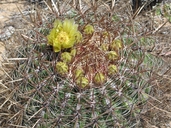Taxon Report
Ferocactus viridescens (T. & G.) Britt. & RoseSan Diego barrel cactus |
 © 2009 Robert Steers |
Taxon Summary
Ferocactus viridescens, commonly known as San Diego barrel cactus, is a perennial stem in the Cactaceae that is found in California and elsewhere. It occurs within Chaparral, Coastal scrub, Valley and foothill grassland, and Vernal pools, growing at elevations from 3 to 450 meters. Ferocactus viridescens is ranked 2B.1, Plants Rare, Threatened, or Endangered in California, But More Common Elsewhere; Seriously threatened in California.Classification
|
Scientific Name: |
Ferocactus viridescens (T. & G.) Britt. & Rose |
|
Common Name: |
San Diego barrel cactus |
| Family: | Cactaceae |
| Element Code: | PDCAC08060 |
| USDA Plants Symbol: | FEVI2 |
|
Synonyms/Other Names: |
|
Ecology and Life History
| Lifeform: | perennial stem |
| Blooming Period: May-Jun | May-Jun |
| Elevation: | 3-450 (10-1475) |
| General Habitats: | Chaparral, Coastal scrub, Valley and foothill grassland, Vernal pools |
| Microhabitat: | |
| Microhabitat Details: |
Conservation Status
| CA Rare Plant Rank: | 2B.1 |
| Global Rank: | G3? |
|
State Rank: |
S2S3 |
| State List: | None |
| Fed List: | None |
| Other Status: | IUCN_LC; SB_CalBG/RSABG; SB_CRES |
|
CRPR Changes: |
|
Occurrence Data from the CNDDB
| Total Occurrences: | 249 |
| Element Occurrence Ranks: | |
| Excellent (A) | 9 |
| Good (B) | 40 |
| Fair (C) | 20 |
| Poor (D) | 26 |
| None (X) | 12 |
| Unknown (U) | 142 |
| California Endemic: False | |
| California Counties and Islands: Name (Code) | |
| San Diego (SDG) | |
| Quads: Name (Quad Code) | |
| Del Mar (3211782), Dulzura (3211667), El Cajon (3211678), Encinitas (3311713), Escondido (3311711), Imperial Beach (3211751), Jamul Mountains (3211668), La Jolla (3211772), La Mesa (3211771), Las Pulgas Canyon (3311734), National City (3211761), Oceanside (3311724), Otay Mesa (3211658), Otay Mountain (3211657), Point Loma (3211762), Poway (3211781), Rancho Santa Fe (3311712), San Luis Rey (3311723), San Vicente Reservoir (3211688), Tecate (3211656) | |
Threat List Data from the CNDDB
| Threat List Total: | 17 | |
| EOs with Threat Listed: | Total EOs | % of EOs |
| 137 | 55 % | |
| Development | 105 | 42% |
| ORV activity | 20 | 8% |
| Grazing | 19 | 7% |
| Road/trail construction/maint. | 16 | 6% |
| Non-native plant impacts | 10 | 4% |
| Foot traffic/trampling | 9 | 3% |
| Military operations | 8 | 3% |
| Other | 8 | 3% |
| Improper burning regime | 7 | 2% |
| Agriculture | 5 | 2% |
| Wood cutting or brush clearing | 5 | 2% |
| Vandalism/dumping/litter | 4 | 1% |
| Recreational use (non-ORV) | 4 | 1% |
| Mining | 3 | 1% |
| Erosion/runoff | 2 | 0% |
| Over-collecting/poaching | 2 | 0% |
| Landfill | 1 | 0% |
Citation
California Native Plant Society, Rare Plant Program. 2025. Rare Plant Inventory (online edition, v9.5.1). Website https://www.rareplants.cnps.org [accessed 22 December 2025].